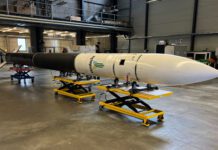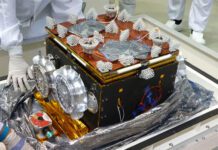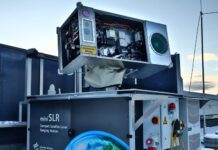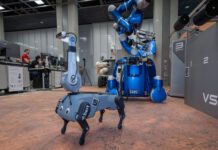
The German Aerospace Center (DLR) MAPHEUS 14 flight was successfully launched from Esrange Space Center in Sweden on 27 February, carrying several scientific experiments. The flight was the third suborbital mission launched from Esrange in 2024.
Launched at 07:27 UTC, the two-stage rocket reached a peak altitude of 265.2 kilometres. The rocket was the first operational flight of the 3.6-metre tall Red Kite motor, which was developed by DLR in collaboration with Bayern Chemie. For the second stage, the rocket made use of an Improved Malemute motor, which is a military rocket motor repurposed for civilian use. This motor is also manufactured by Bayern Chemie. With the addition of the 5.4-metre payload section, the rocket stood at 12.5 metres.
During the flight, the 14 scientific experiments, which had a combined mass of 442.8 kilograms, were subjected to approximately six and a half minutes of microgravity. According to DLR, the payload was split into seven individual experimental units and one shared module, which was managed by the Swedish Space Corporation (SSC) and accommodated seven small experiments.
Payloads:
- COSMO – Examined the flightworthiness of certain components of the rocket.
- ROMS – Studied the effects of microgravity on living human stem cells.
- SOMEX: Experimented with colloidal nanoparticle suspensions.
- NYMEX: Investigated gravity’s effect on cell membrane fluidity.
- LIFT: Induced chemical fixation of biological samples in hypergravity and microgravity.
- MIND-G: Monitored activity of neuronal cells during flight.
- MINIPLAX (shared module): Explored gravity’s impact on cell polarity and cancer development.
- DEIMOS (shared module): Tested powder stabilization for additive manufacturing in space.
- AURORE-II (shared module): Showed microgravity’s effect on liquids. This experiment was developed by the Swedish Astronomical Youth Association.
- ADI-ECHO (shared module): Tested biological cell monitoring and communication in microgravity for Australian startup ResearchSat.
- CEMIR (shared module): Studied the effect of microgravity on bone and muscle cells.
- RADICALS (shared module): Tested a radiation shield for space missions.
Less than an hour after liftoff, the flight’s payloads were successfully recovered for examination by the individual teams.







